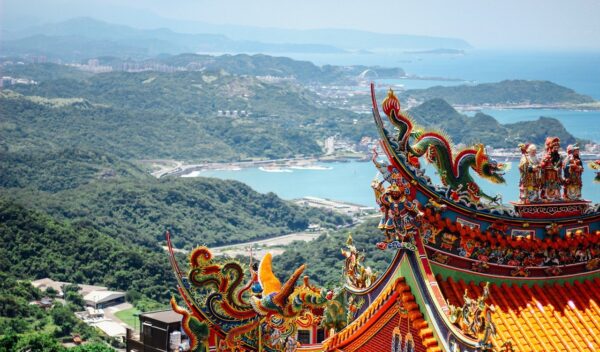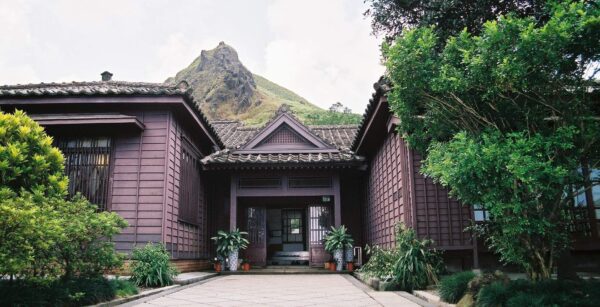Jiufen & Jinguashi | Taiwan

Despite being exceptionally mountainous, Taiwan has few true ‘mountain towns’. Two of the most captivating hillside communities are Jiufen and Jinguashi, side by side and overlooking the ocean about 30 km (19 miles) northeast of central Taipei. In terms of history, the two have a great deal in common; both are former mining towns that boomed from the end of the 19th century until some years after World War II. After the gold and copper mines closed down, most of the inhabitants moved away and these settlements became frozen in time until they were rediscovered by Taiwanese day-trippers and international tourists.
Jiufen: Snacks, stairways, and teahouses
The toponym Jiufen has interesting origins. It means ‘nine shares’ and it’s thought that, before the discovery of gold led to an influx of outsiders, there were just nine households here. Travelling merchants (who were very common in the Taiwan of yore, because few people had any means of transport) knew to arrive with nine portions of whatever they were selling, be it cloth, rice, salt, or dried fish. As a result, the outside world came to refer to this isolated settlement as Jiufen.
Some say that Jiufen should thank movie auteur Hou Hsiao-hsien for its current prosperity, because the decision to set his 1989 masterpiece A City of Sadness here made the town’s unique charms known to people not just throughout Taiwan but also to overseas film buffs. Without meaning to diminish Hou’s achievements as an artist or his sensitive portrayal of this place, we at Life of Taiwan take a different view: Jiufen’s narrow, winding alleys and the superb coastal views it offers would surely have brought tourists here sooner or later.
More recently, many have said that the visuals in the Oscar-winning blockbuster anime fantasy Spirited Away were clearly inspired by the twisting streets of Jiufen, though creator Hayao Miyazaki denies this. Of course, the best thing to do is to see Jiufen with your own eyes, allowing plenty of time to explore the quaint alleyways, try the various snack foods on offer (we recommend taro balls served as a dessert in sweetish gingery soup) and maybe drink some tea in one of its with-views-to-kill-for teahouses.
One of Jiufen’s landmark buildings is Shengping Theatre. Between the 1920s and 1980s, the theatre served as a cinema, a venue for concerts and stage performances (including Taiwanese opera), and a place where visiting politicians would make speeches. Like dozens of similar establishments in small towns all over the island, it closed down soon after ordinary households could afford their own TV sets. In the case of Shengping Theatre, depopulation also dealt a blow to its fortunes. In 2009, the government took control of the property and funded a thorough renovation, turning a delapidated and typhoon-damaged structure into a new cultural hub.
Just outside the town, the hugely photogenic Golden Waterfall is just that: A multi-level cascade that washes down toward the sea over stones that have been stained a brownish-yellow by metals washing out of the ground. Thanks to the region’s pluvial climate, the waterfall is almost always impressively vigorous. If the weather is decent, consider hiking to the top of Mount Keelung (sometimes written Jilong Mountain; 587 m / 1,926 ft), which many people can manage in around half an hour. Once you’ve found the trailhead it’s almost impossible to get lost. From the summit you can usually enjoy great views of Keelung’s Heping Island, nearby Teapot Mountain, and other points along the splendid north coast.
Jiufen is well served by buses (most of which set out from Keelung or Ruifang and continue on to Jinguashi) but these can get rather crowded at the weekend and during the summer holidays. Dense traffic and steep parking fees mean driving here is typically a bad idea. Of course, if you arrive here as part of your personalised Life of Taiwan private tour, your driver-guide will take care of these issues.
Jinguashi and New Taipei Gold Museum
The town is the museum and the museum is the town! For almost all of its existence, Jinguashi has lived in the shadow of Jiufen. The creation of the Gold Museum several years ago reversed its decline by preserving and presenting a fascinating amount of industrial infrastructure. In one exhibition hall, visitors are welcome to touch a 220.3kg gold ingot (at the time of writing, this 99.9-percent-pure treasure was worth around US$15.3 million or GBP11.96 million). Another is a renovated section of mine shaft.
A quarter hour’s walk above the town, the windswept remnants of a Shinto shrine — according to some, the oldest purpose-built structure of that kind in Taiwan — is a reminder of the 1895-1945 period of colonial rule. Because they were overseeing the extraction of minerals from the ground, the Japanese owners of the mining company decided to establish this place of worship to soothe the spirits of nature, lest they be offended by the environmental destruction occuring around Jinguashi.
Another highlight is the Crown Prince Chalet, built in 1922 to provide overnight accommodation for Crown Prince Hirohito (1901-1989) during a state visit to the colony. Hirohito later became the Emperor Showa, guided Japan through its surrender of Japan at the end of World War II, and became the country’s first constitutional monarch. In the end the prince didn’t sleep here, but this delightful structure — made of cypress, red sandalwood, and cherry wood, held together by mortise and tenon joints — has been lovingly maintained.
Another point of interest linked to the Japanese era is a memorial unveiled in 1997 to the Allied servicemen who perished here after being captured in Southeast Asia during World War II. Around 4,300 prisoners-of-war passed through several camps in various parts of Taiwan, the majority being British soldiers who were captured when Singapore fell to Japanese forces in early 1942. Some POWs were from other Commonwealth countries; they suffered alongside a small number of Americans and Dutchmen. The unluckier men were compelled to work in Jinguashi’s mine; as a result of neglect, mistreatment, overwork, and mining accidents, it’s thought that of the first 523 sent to the site, a mere 100 were still alive when the war came to an end.
It’s possible to see almost everything in Jiufen and Jinguashi as a very full day-trip. Staying overnight in a characterful B&B or in the busy port city of Keelung is another option well worth considering.

